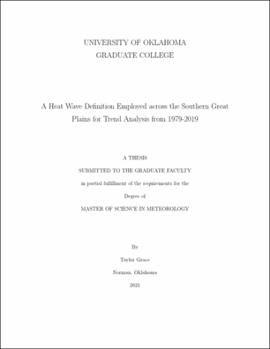| dc.description.abstract | Subseasonal-to-seasonal (S2S) extremes occur frequently in the Southern Great Plains (SGP), more specifically heat waves. Heat waves are expected to increase in frequency, duration, and intensity in several regions globally, yet a single definition to identify heat wave events has not been established. This study focuses on proposing a novel comprehensive heat wave identification methodology and the application of this method to the SGP. Utilizing 2-meter temperatures from the North American Regional Reanalysis data set from 1979 through 2019, the heat wave definition was applied to complete an annual time series, duration, and seasonality analysis within the study spatial domain. Heat wave events in this study are identified when the daily maximum and minimum standardized temperature anomalies were greater than or equal to the 90th percentile for a minimum of three consecutive days. The 90th percentile was determined to be a more ideal relative threshold in comparison to the 95th percentile through statistical analysis of the probability distribution functions of daily maximum, mean, and minimum standardized temperature anomalies across the Southern Great Plains throughout the study time period.
Spatially, a climatology of heat wave events was established on a climate division scale with the employment of three different spatial coverage percentages (i.e., 10%, 25%, and 50%) denoting the percentage of grid points within each climate division where the heat wave methodology was met. Temporal and spatial trends were analyzed from the generated heat wave event climatologies within the annual time series, duration, and seasonality. This study found that the frequency of heat wave events is increasing over the study time period for all ten states within the SGP. Further, Louisiana and Mississippi are more susceptible to longer duration (i.e., 7-day or greater) heat wave events. Lastly, the frequency of heat wave events during all four seasons (i.e., fall, spring, summer, and winter) was increasing through all SGP states. Louisiana had the greatest increasing trend of fall, spring, and winter heat wave events, whereas Texas had the largest increasing trend in summer season heat waves. All relationships appeared within all three spatial coverage methods. The climatologies solved the need of a database of heat wave events in the Southern Great Plains, established on a climate division scale in this study. Furthermore, trends provided insight on the significance of particular years, locations, and future implications of heat wave events within the SGP. This work established the beginning steps in more expansive heat wave research to further analyze precursor, compound, and cascading events between multiple S2S extremes with heat wave events in order to mitigate socioeconomic losses. | en_US |
